Human Flower Project
Religious Rituals
Wednesday, July 11, 2012
Mandorla: Intersecting Worlds
With a tragedy in Russia, mourners and their florists turn to an old figure of Eastern Orthodox iconography, shaped like a seed.

A Russian Orthodox priest blesses graves outside Krymsk.
Overnight floods in Krymsk, a southern Russia city east of the Black Sea, killed at least 172 people early Sunday morning. There had been no warning, even though authorities later admitted having known by 10 p.m. Saturday that heavy rains threatened to inundate the town.
Some of the survivors (more than 25,000 lost their homes and belongings) say they believe that along with flooded natural waterways, more water was actually released from a reservoir above the city, “a theory rebutted by scientists from Russia’s environmental monitoring service, who said Friday’s rains swelled nearby rivers with the equivalent of six months’ average precipitation.”
Recriminations have been mounting. And so have floral tributes to the dead. Thanks to Craig Cramer of Ellis Hollow for alerting us to these striking images taken in a makeshift graveyard outside Krymsk.
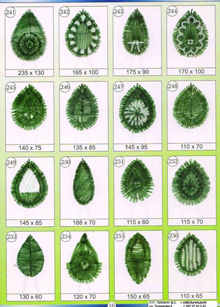 A Ukrainian florist advertises various designs for wreaths, most of them variations on the tear-drop form of the mandorla.
A Ukrainian florist advertises various designs for wreaths, most of them variations on the tear-drop form of the mandorla.
How different these sympathy arrangements are from the circular wreaths and sprays we’re accustomed to. All morning we’ve been searching for clues as to their distinctive shape. Egg? Seed? Womb? Teardrop?
After browsing through Russian and Ukrainian florists websites, we’re still not certain why this form of tribute is such a consistent floral presence at funerals in the region. We’ve read that even-numbered flowers are preferred (even required) at times of mourning and that yellow blooms are unwelcome at happy or sad occasions alike.
Having read up on Russian funeral customs and dipped into church symbolism, we’ve come to think that the massive oval-shaped arrangements follow an iconic shape in Eastern Orthodoxy—the mandorla.
This encapsulating form recurs in Christian imagery, a kind of radiant bubble that surrounds divine figures when they appear to humankind.
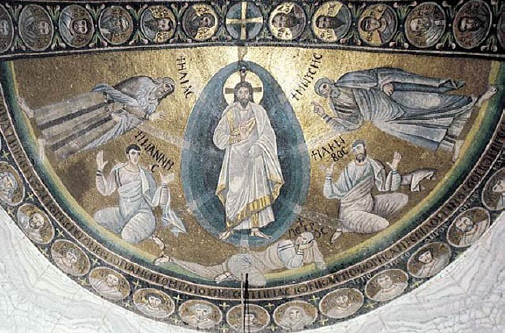
One of the earliest such images is this Apse mosaic of the Transfiguration, St. Catherine’s Monastery, Mount Sinai, c. 550-565
“The term refers to the almond like shape: “mandorla” means almond nut in Italian. In icons of the Eastern Orthodox Church, the mandorla is used to depict sacred moments which transcend time and space, such as the Resurrection, Transfiguration, and the Dormition of the Theotokos.”
In Pythagorean symbolism and pre-Christian art, the mandorla shape was conceived as two intersecting circles, alluding again to a kind of “eclipse,” when two different dimensions coalesce; momentarily, there’s a keyhole that makes it possible to see a more essential reality than we know in everyday life.
These pendulous wreaths, often fashioned with concentric rings of flower-color, remind us of the luminous cloud around our Lady of Guadalupe, a form that both protects and projects the power residing inside.
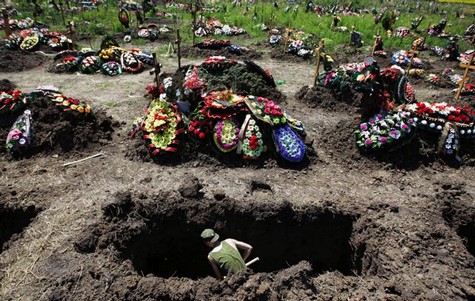
A soldier digs a grave outside Krymsk, Russia. More than 170 residents of the town died in early morning floods Sunday July 8.
Photo: Sergey Ponomarev, for AP
The intersection of opposites certainly comes through in Sergey Ponomarev’s astonishing photo from the Krymsk cemetery. A pale young man (or is it a girl?) shovels inside a grave, a black block surrounded with mud, while on the ground above scores of the bright egg-shaped arrangements lie across fresh gravemounds; all the way to the horizon, they shine back at the sky.
Wednesday, June 27, 2012
Conceptual Gardening
With design, aesthetics and ecological concerns leading the way, symbolism isn’t much of a force in contemporary gardening. But we offer two examples where concept dominates, one noble, the other daffy.
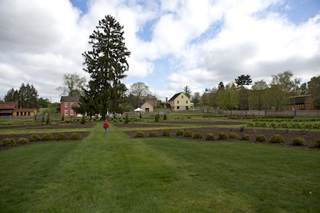
The Zoar garden with its symbolic spruce at the center.
Our first stab at a garden, on High St. in Lexington, Kentucky, was as conceptually ambitious as it was horticulturally shaky. (Aesthetics/design? What are those?)
In a squarish back yard surrounded by a high (inherited) fence, we planned an astrological garden, sectioning the perimeter into 12 beds and designating each to a zodiacal sign, Aries to the East, Cancer to the North, Libra toward the West, and Capricorn on the South. Then we went about finding plants and objects that corresponded to each sign.
Windflowers? In Gemini of course. Zinnias for Leo. A vine of moonflowers under Cancer, etc. At a flea market we came upon a very strange plaster statue: a monkey in a blue nurse’s uniform holding a bedpan. Perfect for Virgo!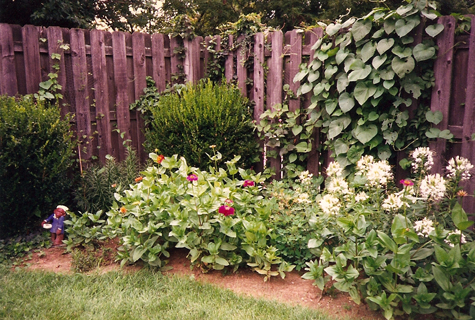
The astrological garden on High St., Lexington, KY: Leo zinnias and Virgo orderly.
Photo: Human Flower Project
On the evening of the summer solstice, 1997, we invited about thirty friends over and had them stand around the edges of the yard at their proper astrological stations, and beginning with Mimi Pickering (born closest to the spring equinox and thus the “firstborn” of the zodiacal year), each guest announced his or her birthdate as well as a “fairy name.”
After we’d all come full around the year, ending with Edward Roberts, born March 17, we planted a redbud tree in the center of the yard, watered by Nina McCormack and Marty Newell, the two Aquarians present.
This very contrived endeavor came to mind recently as we read about a far more serious conceptual garden at the Village of Zoar, Ohio, a town of German Separatists that, some claim, had the first communal society of any European immigrants to the U.S.
The Village of Zoar was named this year as one of the most endangered historical places by the National Trust for Historic Preservation. The entire town—including its garden—may be flooded if the Army Corps of Engineers decides not to rebuild a crumbling levee on the Tuscarawas River.
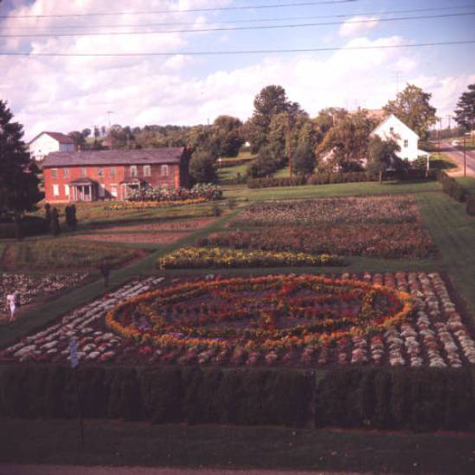
Zoar Garden circa 1960
Photo: Columbus Dispatch
The original settlers came to the U.S. in 1817 to escape religious persecution in their homeland. As a reflection of both their faith and their belief in a communal society, the villagers constructed in the center of town a large garden, designed after the book of Revelation, Chapter 21.
James Griffing, a 19th century visitor, wrote: “In the center of the garden stood a Norway spruce representing everlasting life, and around the tree was an arbor vitae hedge symbolizing heaven; This in turn was surrounded by twelve juniper trees; one for each of the apostles… A circular walk enclosed the centrum, and from this twelve other walks representing various paths to heaven radiated to the four sides of the garden. These in turn were intersected by walks which symbolized the worldly ways through which people wander on earth before they find salvation.”
How enlightened to recognize that many paths lead to heaven.
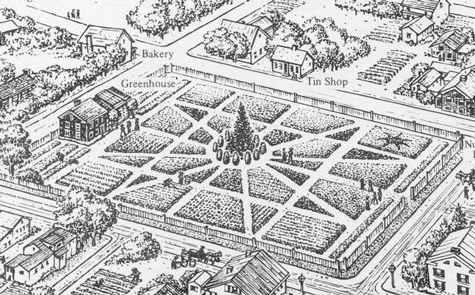
Drawing of the Zoar Garden with its radiating path and central spruce, representing Christ.
A more contemporary and horticulturally-minded historian writes, “Although some vegetables and fruits were grown here, the garden was filled mainly with flowers.” Is there a plant list anywhere? We haven’t found one, but as a former “conceptual gardener” (though a pagan one), we feel certain that as with our Gemini windflowers, the plants the Zoar gardeners chose symbolized some tie to their aspiration and greater design – the New Jerusalem.
Gardening & Landscape • Religious Rituals • Secular Customs • Permalink
Wednesday, June 06, 2012
Birches at Pentecost
In the Orthodox Church, Holy Trinity (50 days after Easter) is draped with the greenery of birch boughs.
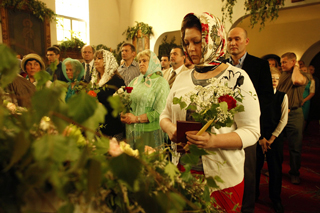
Pentecost 2012, at Saint Nicholas Russian Orthodox Cathedral, Seattle, Washington: the church is decorated with birch branches and flowers in observance of the Holy Spirit’s presence.
Photo: Erika Schultz/Seattle Times
In the Protestant denomination of our raising – the Episcopal Church – Pentecost meant an outpouring of red Sunday outfits and searing reference to the apostles’ “tongues of fire.” In the Eastern Orthodox faith, Pentecost – better known as Trinity Sunday – is green.
The Orthodox clergy wear green vestments shot through with golden threads, and churches are generously festooned with boughs of birch. Clusters of the spring leaves, heart shaped and serrated, stand in windows, adorn pulpits, and surround icons. In some parishes, stems of birch are scattered over the church floors, too. It’s as if the Holy Spirit descended not as fire but wind, shredding the trees outside and gusting them into the nave.
Saturday, May 05, 2012
Araceli’s Flowers on a Seat of Honor
The patron saint of Lucena inspires a distinctive floral outpouring from the faithful of Southern Spain.

The Virgin of Araceli, patroness of Lucena, Spain, dressed in typical Andalusian costume
Photo: Oracion Año Jubilar
On the first weekend in May, residents of Lucena, Spain, make splendid veneration of their town’s patron saint the Virgin of Araceli.
This year the celebration promises to be especially lavish and well attended as it marks a “jubilee,” 450 years since the sacred statue came to Lucena from Rome. The town stretches out its season of celebration from April 30 forward (May is the traditional month of Mary), though Saturday May 5 is climactic: the major procession, will involve the formal offerings of flowers to Our Lady, as the statue moves from a shrine on the outskirts of town through the city to the church downtown.
“As usual, the procession will depart from Paseo de Rojas, and conclude in the Parish of San Mateo, which is home to the Lady of Lucena.

